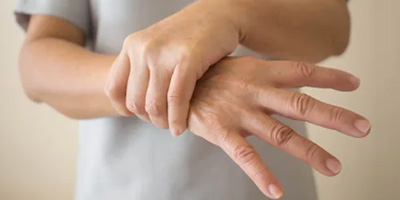What is Parkinson’s disease?
Parkinson's disease is the second most common neurodegenerative disorder after
Alzheimer's disease. It is mostly a disease of old age, affecting people above 50
years. About 5% develop young-onset Parkinson's disease before the age of 40
years. Parkinson’s disease is caused due to degeneration of cells in a region of the
brain known as substanEa nigra, which produces a chemical called dopamine.
Reduced dopamine in the brain produces the clinical manifestaEons of Parkinson's
disease. Common symptoms are slowness in activities, stiffness, and tremors. As
the disease progresses, walking and balance are also affected.
What causes Parkinson's disease:
In most cases, the cause for Parkinson's disease is not known and hence it is called
idiopathic Parkinson's disease. Several factors appear to play a role in the
development of Parkinson's disease, including genes and environmental triggers.
Toxins like pesticides, illicit drugs (MPTP), and head trauma can increase the risk of
developing Parkinson's disease. In about 5-10 % of cases, a genetic problem can
be identified.
What are the symptoms of Parkinson's disease?
Symptoms of Parkinson's disease can be divided in motor and non-motor symptoms.
Motor symptoms
Slowness: In patients with Parkinson’s disease, the movements become slow, and
it takes more time to finish a task. Slowness can affect one side of the body more
than the other. Walking also becomes slow in more advanced stages.
stiffness: stiffness can start in any limb but eventually affects the whole of the
body. Parkinson’s disease commonly presents as shoulder stiffness and is often
misdiagnosed as frozen shoulder. stiffness as a symptom can be very disabling.
Tremor: Tremor in Parkinson’s disease usually start in one limb and eventually
affects other limbs and both sides of the body. The tremor is classically present at
rest and reduces with limb movement.
Walking and balance problem: Parkinson’s disease patients walk slowing with
small steps. In more advanced stages shuffling develops, which is dragging of the
feet without lifting them fully off the ground. Freezing while walking may develop
in some patients in which the steps become smaller and smaller till walking stops.
Freezing can happen any time during walking but is more common at turns and
while walking through narrow passages like through a door. Balance can also be
affected resulting in falls.
Speech: Parkinson's disease paEents have a low volume and monotonous (flat)
speech. As the speech is soft, it is often hard to for the caregivers to understand.
Non-motor symptoms
Constipation: Constipation is a common symptom in Parkinson's disease and can
be seen many years before the diagnosis of Parkinson’s disease is made.
Constipation can also be a side effect of some medications used in the treatment
of Parkinson’s disease.
Sleep problems: Patients with Parkinson's disease can have sleep initiation
(difficulty in falling asleep) or sleep maintenance (difficulty in staying asleep)
problems. At times sleep is disturbed because of stiffness in body or increased
frequency of urination at night (nocturia) resulting in frequent awakenings. REM
sleep behavior disorder (RBD) is a common symptom of Parkinson's disease. It
may start many years before the diagnosis of Parkinson's disease is made. In this
disorder, the patient speaks and moves in dreams, sometimes causing injury to
self or bed partner.
Autonomic dysfunc/on: Autonomic dysfunction is common in advanced
Parkinson's disease but sometimes can be seen even in the early stages. Patients
feel dizzy or light-headed while standing due to a drop in blood pressure. This can
result in a fall. Bladder symptoms like urgency and incontinence are common.
Episodes of profuse sweating can be very inconvenient and embarrassing.
Cognition: Cognition is usually preserved till late in Parkinson's disease. When cognition is affected patients may have difficulty in remembering new things,
difficulty in multitasking, planning and navigation. Visual hallucination are
common in Parkinson's disease dementia and can be very disabling.
Mood and behavior: Mood changes are commonly seen in Parkinson's disease, even in the early stages. Depression is very common, and early identification and treatment can significantly improve the quality of life. Some patients may develop mania or bipolar disorder. Delusions can be present in patients with Parkinson's disease dementia. Impulse control disorders like compulsive eating, shopping, and hoarding can be a side effect of drugs used in the treatment of Parkinson's disease.
How is Parkinson’s disease treated?
There are many effective oral medications for the treatment of Parkinson’s disease. In mild and young cases dopamine agonists are usually prescribed. The most effective medication in the treatment of Parkinson’s disease is Levodopa. Levodopa is converted to dopamine (chemical deficient in Parkinson’s disease brain) after it enters the brain. Levodopa improves most of the symptoms of Parkinson’s disease including tremor, stiffness, slowness and walking difficulty. It has to be taken empty stomach, multiple times a day. Non-motor symptoms like constipation, sleep problems, REM sleep behavior disorder, orthostatic intolerance and cognitive decline can be treated with medications and lifestyle changes.
Surgical options are available for advanced cases or when symptoms are not well controlled with oral medications.
Is there a surgical treatment for Parkinson’s disease?
Deep brain stimulation (DBS) is the surgical procedure for treating Parkinson’s disease. DBS is considered in Parkinson’s disease when symptoms are not adequately controlled with medications. As the disease progresses, patients develop unpredictable OFF periods and dyskinesia (involuntary dance-like movements). after a certain stage, oral medications may not be effective in controlling these symptoms. DBS is an effective surgical option in these patients and symptoms of tremor, stiffness, and slowness are well controlled after the surgery. As medications are reduced post-surgery, dyskinesias also improve.
Before the surgery, a movement disorders specialist conducts an extensive assessment including evaluation of medications, symptoms, and response to oral Levodopa. A detailed evaluation of cognition by a neuropsychologist is also done.
The surgery of DBS is done in two stages. In the first stage, the electrodes are inserted in the brain under stereotactic guidance. During this part of the surgery, the patient is awake. In the second stage, the impulse generator (IPG) or the pacemaker is placed under the skin of the chest. The brain electrodes are then connected to the pacemaker with connecting wires tunneled beneath the skin. The second stage of surgery is done under general anesthesia.
The programming of the impulse generator (IPG) is done after the surgery. It may take a few days to weeks to reach the optimal setting, as the current increase has to be done slowly to allow the brain to adapt. The programming of the IPG is done by a movement disorders specialist as an outpatient procedure.




